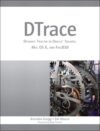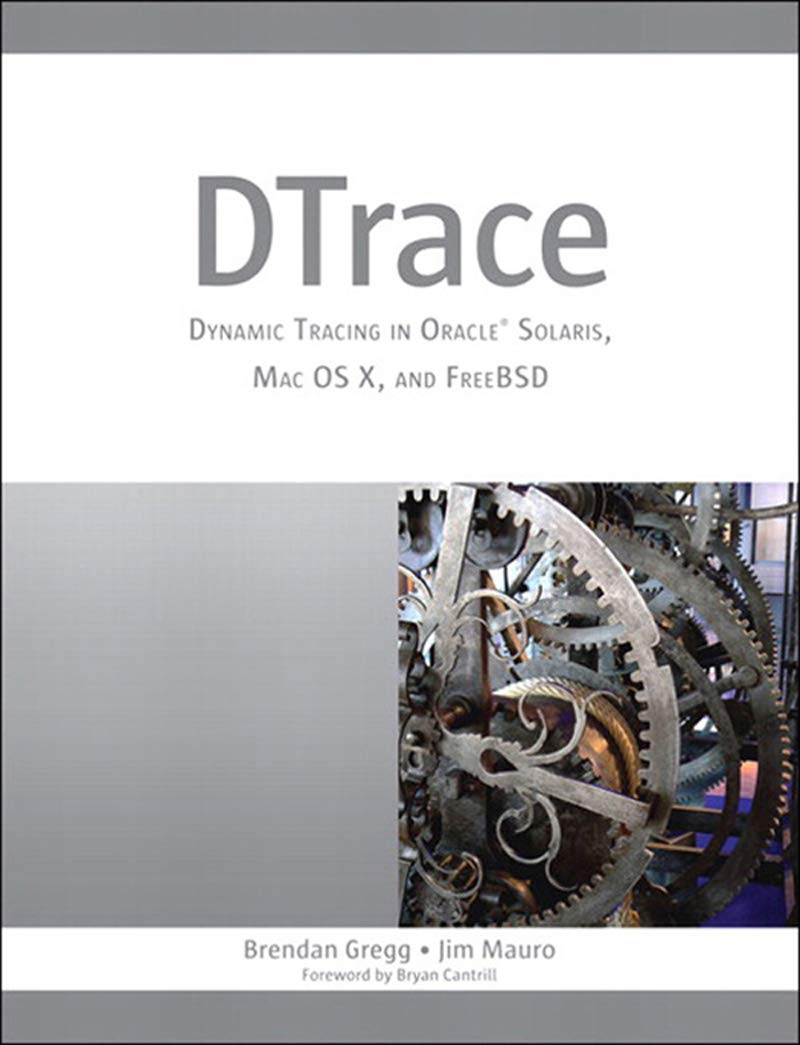DTrace: Dynamic Tracing In Oracle Solaris, Mac OS X, And FreeBSD By Brendan Gregg And Jim Mauro

€46.39
DTrace: Dynamic Tracing In Oracle Solaris, Mac OS X, And FreeBSD By Brendan Gregg And Jim Mauro Price comparison
DTrace: Dynamic Tracing In Oracle Solaris, Mac OS X, And FreeBSD By Brendan Gregg And Jim Mauro Price History
DTrace: Dynamic Tracing In Oracle Solaris, Mac OS X, And FreeBSD By Brendan Gregg And Jim Mauro Description
DTrace: Dynamic Tracing In Oracle Solaris, Mac OS X, And FreeBSD by Brendan Gregg and Jim Mauro
If you’re looking to dive deep into performance analysis and troubleshooting, “DTrace: Dynamic Tracing In Oracle Solaris, Mac OS X, And FreeBSD” is a must-read. This comprehensive book by Brendan Gregg and Jim Mauro offers essential insights into DTrace, which is a powerful tool for real-time system tracing. Whether you’re a system administrator, developer, or IT professional, this book will enhance your understanding and application of dynamic tracing.
Key Features of DTrace: Dynamic Tracing
- Comprehensive Guide: This book includes vital information about using DTrace across multiple operating systems. From Solaris to Mac OS X and FreeBSD, it’s your go-to resource for mastering dynamic tracing.
- In-Depth Examples: The authors provide a wealth of practical examples and scenarios that illustrate the capabilities of DTrace. You’ll learn to solve complex problems using real-world applications.
- Expert Insight: Written by two prominent figures in system performance, both Brendan Gregg and Jim Mauro bring their extensive experience to the table, making complex topics accessible and engaging.
- Illustrative Graphics and Charts: Visual aids throughout the book help you understand intricate concepts more easily, enhancing your learning experience.
- Enhanced Accessibility Features: The book is designed with accessibility in mind, featuring support for Text-to-Speech and Screen Readers, making it accessible for all users.
- Device Compatibility: This edition allows usage on up to five simultaneous devices, ensuring you can access it wherever you need.
- Extensive Print Length: Spanning 1544 pages, it offers ample content to cover everything you need to know about DTrace.
How the Price Compares Across Different Suppliers
The price for “DTrace: Dynamic Tracing” varies across multiple platforms. On our price comparison site, you can find competitive offers from major suppliers. Generally, prices range from $30 to $60, allowing you to choose an option that fits your budget. Check regularly for the best deals on this essential resource.
Trends From the 6-Month Price History
Our 6-month price history chart reveals interesting trends for the book’s pricing. Recent spikes indicate increased interest in DTrace as more professionals recognize its importance in the evolving tech landscape. Prices have fluctuated, peaking at $60 during high demand phases, particularly in the lead-up to tech conferences and workshops focusing on system performance.
Insights From Customer Reviews
Customer feedback for “DTrace: Dynamic Tracing” highlights several positive aspects. Many users praise the authors’ clear explanations and helpful examples that make learning dynamic tracing approachable. Users value the extensive coverage of different operating systems, making it applicable for a broader audience.
However, some readers noted that the depth of content may be overwhelming for beginners. Those without prior knowledge of system performance may find certain sections challenging. Yet, many agree that grappling with the material is worth the effort for the insights gained.
Engaging Multimedia Resources
To further enhance your learning experience, we provide links to various YouTube review and unboxing videos of “DTrace: Dynamic Tracing.” These multimedia resources can offer additional perspectives and facilitate a richer understanding of the material. Explore visual demonstrations that complement the text and see what readers are saying in their reviews.
Why You Need This Book
With the increasing complexity of software systems, mastering dynamic tracing has never been more critical. DTrace allows you to trace real-time operations, enabling troubleshooting at unprecedented levels. This book is not only a technical guide but also a stepping stone towards enhancing your professional skills in systems analysis and performance optimization.
“DTrace: Dynamic Tracing In Oracle Solaris, Mac OS X, And FreeBSD” is an asset for anyone looking to improve their technical acumen in system performance. Don’t miss out on the opportunity to take your skills to the next level.
Compare Prices Now!
Harness the power of “DTrace” and master dynamic tracing techniques. Use our price comparison tool to find the best deals on this invaluable resource. Start your journey today!
DTrace: Dynamic Tracing In Oracle Solaris, Mac OS X, And FreeBSD By Brendan Gregg And Jim Mauro Specification
Specification: DTrace: Dynamic Tracing In Oracle Solaris, Mac OS X, And FreeBSD By Brendan Gregg And Jim Mauro
|
DTrace: Dynamic Tracing In Oracle Solaris, Mac OS X, And FreeBSD By Brendan Gregg And Jim Mauro Reviews (6)
6 reviews for DTrace: Dynamic Tracing In Oracle Solaris, Mac OS X, And FreeBSD By Brendan Gregg And Jim Mauro
Only logged in customers who have purchased this product may leave a review.







![Xtssui 64GB – Bootable Windows USB Driver By [Author’s Name]](https://discompare.eu/wp-content/uploads/thumbs_dir/64gb-bootable-windows-usb-driver-by-authors-name-qysjt1lasby2iglqms9moj0w8aaprfwnhhdhp7sgzk.jpg)
B. Rockwood –
Its finally here, the great masterpiece. This books completes what “Solaris Performance & Tools” started. This new book focuses entirely on DTrace and is really several books rolled into one.
Part I gives you a complete DTrace Textbook. It breaks down the language and introduces you all the foundational concepts. It is brisk and every concept has an example making it extremely accessable.
Part II is the combination of several runbooks and a collection of cookbooks. For CPU, I/O, network, etc there is the same methodical systematic approach to exposing problems that we got in “Performance & Tools” but vastly expanded. After hitting all the fundamental resources it breaks down into various programming languages, databases, applications and daemons.
The true value of this book is here in Part II. You may know that you have a certain kind of problem, and you know that DTrace can probly find it for you, but you don’t know where to start and in what order to proceed. If you do it on your own you may quickly find yourself overwhelmed and lost in the labyrinth that is the Solaris kernel. This is why the methodical approach Jim and Brendan take is so important, you really don’t need to know anything more than you need to dig into some broad problem and the text leads you down the path of elimination and analysis step-by-step.
Part III hits tools, tips, and security. Learn how to spy on users, audit activity, use Apple Instruments or DTrace in NetBeans and lots more. Chapter 13 on tools is a great way to learn about all those tools out there that you may have heard of but aren’t familiar with, or even introduce you to new toys you didn’t know existed.
But thats not all… there are 7 Appendix, including a complete language reference, error message reference, and cheat sheet.
The important thing about this book is that it will actually help you solve real-world problems. A hardworking sysadmin doesn’t have the time it takes to learn all the ins-and-outs of Solaris’s kernel and learning all of DTrace’s power can take years. The book is full of examples, I think have the page count has to be just code examples that you can actually use. This book is practical, accessible and will turn any Solaris administrator into an instant rock star.
Keith –
The book provides detailed information and many examples. But they’re all for Solaris and, in many instances, must be ported. But the book provides sufficient information to allow you to do that if you have the source for your OS.
Jeff Benshetler –
This is a good way to get started using DTrace on Solaris or FreeBSD. (I haven’t tried the Linux version.) The book does a good job describing the overall structure of a DTrace script, including providers, probes, conditions, and actions. It also has a number of good examples, although perhaps 25% of the example no longer work because DTrace is evolving rapidly. That DTrace has rapidly evolved beyond what it was when this book was publish is the reason the book gets 4 stars instead of 5.
The book is well worth the purchase as a learning tool albeit less useful as a reference.
DetlefD –
This is a must-read book if you plan to use DTrace for your needs. It not only explains the syntax and HowTo of Dtrace. It also shows many examples and – very useful – discusses the results and some background that makes it easier to understand the results of the scripts. That makes the book a real win – it’s not just an explanation of Dtrace, but also a book to understand better the tools for systems monitoring and tracing. All this is clearly a result of the experience of the two expert authors Brendan and Jim.
Christopher Cope –
Everything you really need to know about DTrace in a single book, yet with plenty of examples, source, and references to branch out from.
Darrin Johnson –
In a nutshell, it is a very good book especially once you get beyond the narcissism embedded in the forward and introduction. From my perspective this book serves three valuable purposes – as a tutorial, as a reference, and a resource for cool tips, tricks and generally making an software engineer’s life easier.
As a tutorial, this book provides one of the most cogent introductions to Dtrace I have seen including web content and prior books. The book, in a couple of chapters, provides a good overview of the purpose and architecture of Dtrace, the D language semantics to rudimentary examples including the canonical “Hello World”. As a tutorial is great for both the neophyte and seasoned engineers. The rest of the book continues tutorial delving into key subsystems (e.g. CPU, Memory, IO, low-level networking, filesystems, etc.) to language to application use of Dtrace. Each section will provide a good introduction and numerous valuable examples to the engineer interested in each respective area.
Probably the weakest aspect of this book is as a pure reference book but I don’t think that is its intent. The book includes several valuable appendices on Dtrace Tunable Variables, D Language Reference, Provider Arguments, etc. However it is likely that most engineers will tag key sections that are relevant to their particular interests/needs.
Also a book of cool tips and tricks, this books has a huge number examples, Tips and Tricks section, Tools, etc. with every engineer (system, middleware, end-user application development) benefiting from the specific examples and/or the ideas being conveyed. I would say that this is especially useful for even the engineers who may already be familiar with Dtrace but haven’t leveraged it’s capabilities to the fullest.
However on the downside this book doesn’t provide a comprehensive to non-dtrace based observability nor does it cover the limitations (e.g. data flow through network stack) and consequences of using dtrace (e.g. probe effect, etc.) at least from my review of the content. However as a resource it is very useful to both new hires and seasoned engineers and
is a complementary to the slightly dated “Solaris(tm) Performance and Tools: DTrace and MDB Techniques for Solaris 10 and OpenSolaris” book by Solaris(tm) by Richard McDougall, Jim Mauro and Brendan Gregg.
Overall a definite buy!